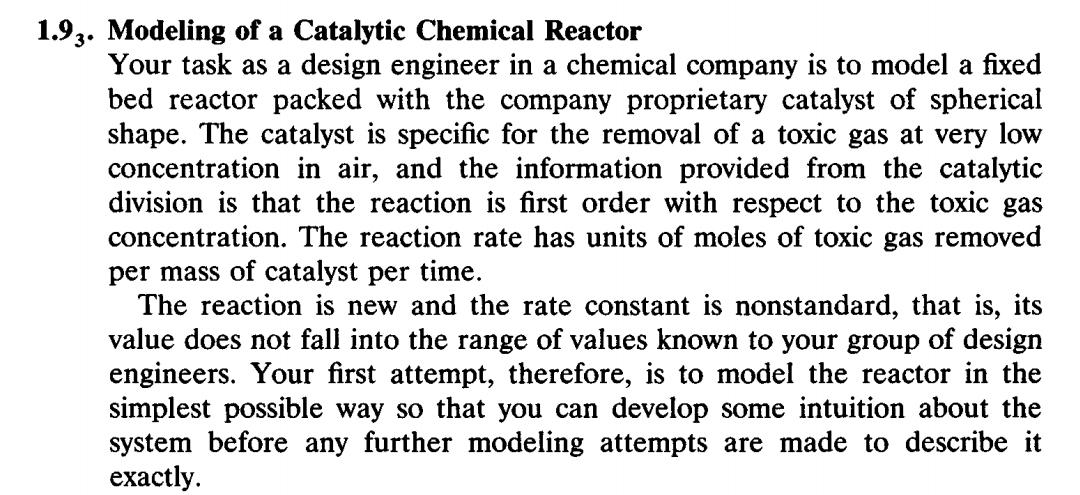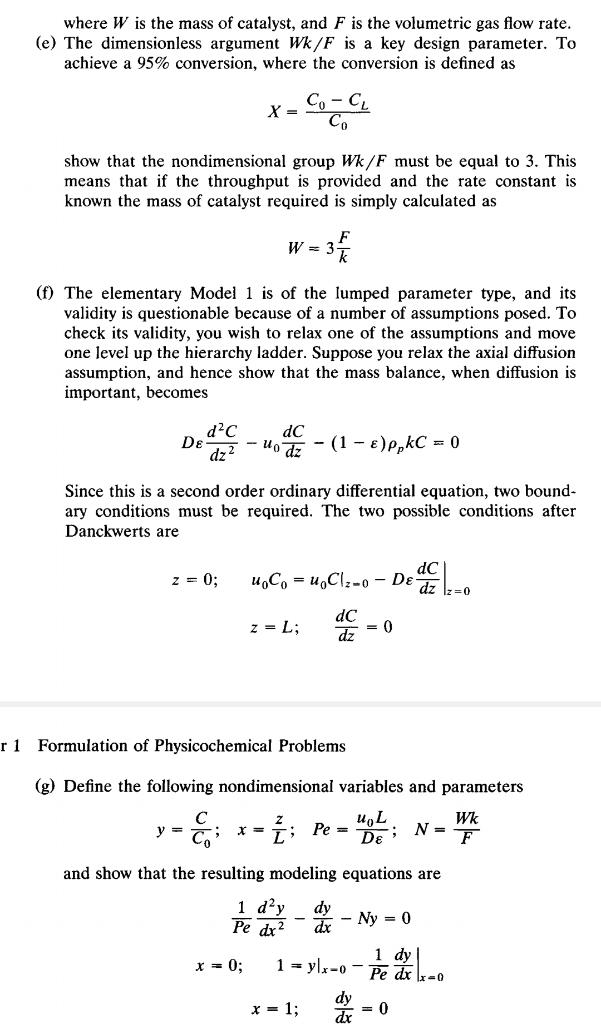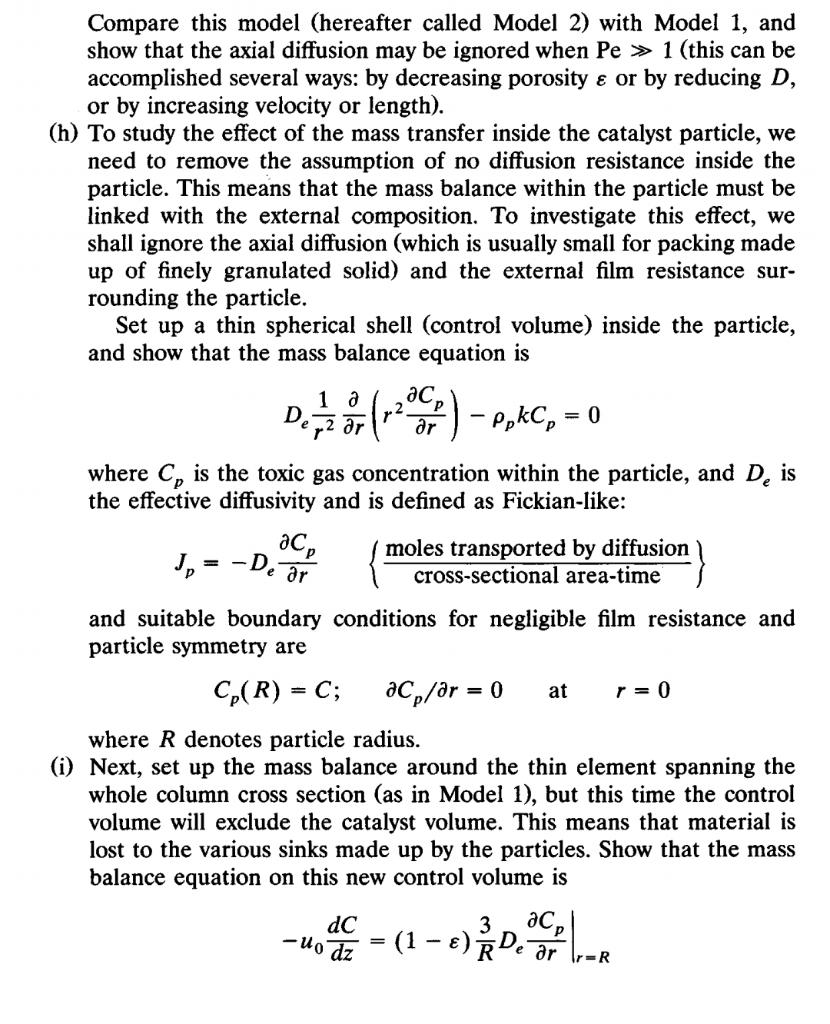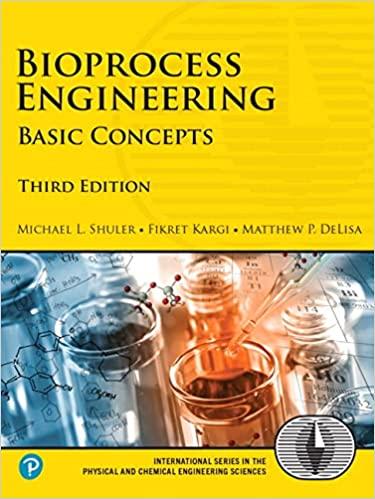


1.93. Modeling of a Catalytic Chemical Reactor Your task as a design engineer in a chemical company is to model a fixed bed reactor packed with the company proprietary catalyst of spherical shape. The catalyst is specific for the removal of a toxic gas at very low concentration in air, and the information provided from the catalytic division is that the reaction is first order with respect to the toxic gas concentration. The reaction rate has units of moles of toxic gas removed per mass of catalyst per time. The reaction is new and the rate constant is nonstandard, that is, its value does not fall into the range of values known to your group of design engineers. Your first attempt, therefore, is to model the reactor in the simplest possible way so that you can develop some intuition about the system before any further modeling attempts are made to describe it exactly. where W is the mass of catalyst, and F is the volumetric gas flow rate. (e) The dimensionless argument Wk/F is a key design parameter. To achieve a 95% conversion, where the conversion is defined as Co-C X = Co show that the nondimensional group Wk/F must be equal to 3. This means that if the throughput is provided and the rate constant is known the mass of catalyst required is simply calculated as F W = (f) The elementary Model 1 is of the lumped parameter type, and its validity is questionable because of a number of assumptions posed. To check its validity, you wish to relax one of the assumptions and move one level up the hierarchy ladder. Suppose you relax the axial diffusion assumption, and hence show that the mass balance, when diffusion is important, becomes d2C De dz2 dC - no dz - (1 - EP KC = 0 Since this is a second order ordinary differential equation, two bound- ary conditions must be required. The two possible conditions after Danckwerts are 4.Co uC\z-e - De .. dc z = 0; z = L; dC = 0 dz r1 Formulation of Physicochemical Problems (g) Define the following nondimensional variables and parameters Pe=uot; UL y = Wk N = F and show that the resulting modeling equatio 1 day dy Pe drzdx - Ny = 0 x = 0; 1 dy 1 = yls-o-Pedas hace - x = 1; dy dr Compare this model (hereafter called Model 2) with Model 1, and show that the axial diffusion may be ignored when Pe 1 (this can be accomplished several ways: by decreasing porosity or by reducing D, or by increasing velocity or length). (h) To study the effect of the mass transfer inside the catalyst particle, we need to remove the assumption of no diffusion resistance inside the particle. This means that the mass balance within the particle must be linked with the external composition. To investigate this effect, we shall ignore the axial diffusion (which is usually small for packing made up of finely granulated solid) and the external film resistance sur- rounding the particle. Set up a thin spherical shell (control volume) inside the particle, and show that the mass balance equation is 1 a ac 2 De - , = ar where C, is the toxic gas concentration within the particle, and Dis the effective diffusivity and is defined as Fickian-like: ace moles transported by diffusion cross-sectional area-time Doktor CM) -e,KC, = 0 P Jo = -De r = at and suitable boundary conditions for negligible film resistance and particle symmetry are Cp(R) = C; aCp/ar = = 0 r = 0 where R denotes particle radius. (i) Next, set up the mass balance around the thin element spanning the whole column cross section (as in Model 1), but this time the control volume will exclude the catalyst volume. This means that material is lost to the various sinks made up by the particles. Show that the mass balance equation on this new control volume is dC 3 OCP - uo dz = (1 ) De - E e ar Ir-R









